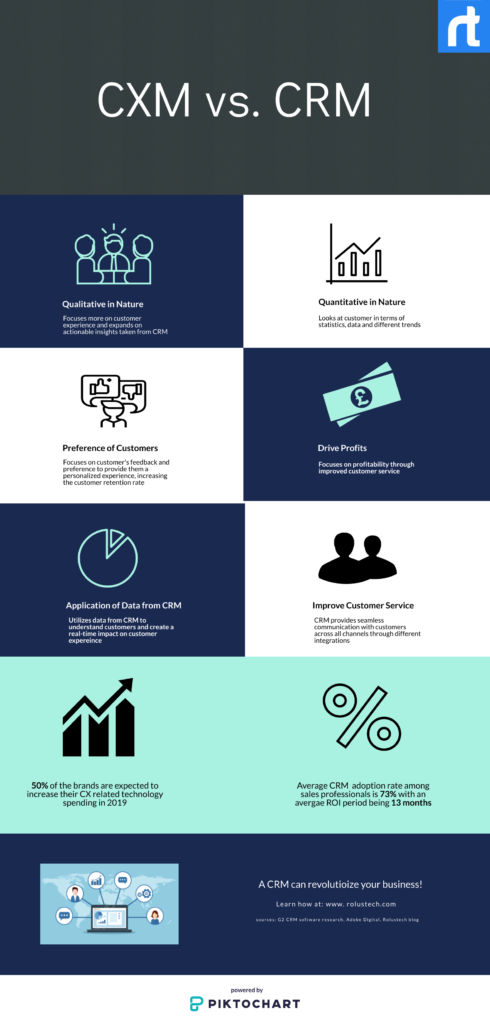CRM – Customer Relationship Management is a term that describes the strategies and technologies used for managing an organization’s interaction with its customers, both current and potential. The purpose of SugarCRM, like a CRM, was to benefit an organization by allowing them to better understand their customers. For instance, by focusing on the marketing strategy, sales analysis, and technical support, businesses were able to comprehend who their customers were. This would help make the sales efforts directed towards those customers seem more relevant.
However, creating a platform for interaction using SugarCRM was just the first step to managing customer relationships. The next step that companies need to take is known as CXM – Customer Experience Management, which is often mixed up with CRM due to the similarity that they have in basic functionality. Learn about some of the best CRM platforms for small businesses.
Customer Experience Management (CXM), on the other hand, attempts to understand as well as influence customer perceptions regarding a business and its products at the various touch points of the customer journey. By doing so, the business tries to increase the value of its customers by encouraging them to spend more on its products or services. This brief introduction of CXM shows how much different it is from CRM.
 CXM Salient Features
CXM Salient Features
There are a few features of Customer Experience Management that help to distinguish it from Customer Relationship Management. Some of those features are explored below. However, what both attempt to do is win customer trust in order to be able to close more sales.
More Qualitative in Nature
While the CRM software looks at customers in terms of statistics, CXM takes more of a qualitative approach. It is more about the experiences that the customers have faced when interacting with the business. The qualitative nature of CXM further expands upon the information gained through CRM, making it more actionable.
CXM Is Even More Customer-Centric
Customer Relationship Management (CRM) attempts to increase the profitability of the business by trying to satisfy the needs of the customers as efficiently as possible while making a profit in the process. CXM takes that one step further by molding favorable experiences for the customers so not only to establish a favorable image in their minds about the business but also so that they keep coming back for more.
CXM encourages the business to take into account the perspective of the customer when making a decision. As a result, CXM allows the business to provide a more customized experience to its customers by keeping a track of their preferences. Thus, while CRM comes after the experience, CXM works hard on anticipating it.
Applies the Data Gained from CRM
During the process of CRM, much of the data is gained by businesses about their customers. Although it is also used in CRM, CXM makes better use of that data in understanding the customers of a business, helping to give them exactly what they want, whenever and wherever they want it.
RT CXM – Rolustech’s Premier Solution for Your CXM Needs
Rolustech has also developed a software solution to cater to the Customer Experience Management (CXM) needs of businesses. This is in the form of a SugarCRM plugin. Using this plugin, businesses can manage the experiences of their customers during their interactions through one of the major customer touch-points, the website. This plugin, RT CXM, is the perfect tool for businesses that want to combine their CXM efforts with their CRM solution.
The RT CXM plugin, Rolustech’s premier CXM solution for SugarCRM, offers seamless WordPress Integration with Sugar. Hence, you can leverage valuable visitor profile information and intelligently interact with them in real-time from within the Sugar interface. Learn all about RT CXM and the full range of SugarCRM plugins and Industry Solutions by Rolustech.
Key Takeaways!
Although the terms Customer Relationship Management (CRM) and Customer Experience Management (CXM) might be used interchangeably at some times, their meanings do have their differences. Whereas CRM involves the optimization of the internal processes of a business, CXM has a more customer-centric approach. CXM differs with CRM in that it is more qualitative in nature, makes use of the CRM data in customer service and attempts to improve customer ‘experiences’. Therefore, now that the differences between the two terms have been clarified, more care should be taken when using either of the terms. Furthermore, since the marketing trends are shifting from the sellers to the buyers, more focus should be placed on CXM as a strategy to retain customers. RT CXM is one such tool which helps better approach the customers and their needs.
Rolustech is a SugarCRM Certified Developer & Partner Firm. We have helped more than 700 firms with various SugarCRM integrations and customization. Get in touch today for your FREE Business Analysis. We will be happy to assist you!




